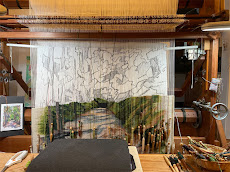Well, these days it's harder and harder to Ac-Cent-Tchu-Ate the Positive but I think it's time to try. The Negative simply doesn't work. Mister In-Between, that old fence sitting son of a gun? No need to mess with him (yes, gotta be a "him").
But before accentuating the positive, I will mention the very negative and tragic events that are happening in the Great Smoky Mountains. Wild fires have been going on throughout the Appalachians for weeks now (in spite of practically no national news coverage about it). Many of the fires that have now reached thousands and thousands of acres appear to be of "human origin" (read vandalism, carelessness, or out-right stupidity).
The fires have been raging throughout North Carolina, Georgia, Alabama, and Tennessee, stretching resources thin. Firefighters have come from all over the country to help battle the fires. The extended drought conditions of the Southeast combined with the fall leaf season, plus several recent days of high winds and the fires have been extremely hard to contain.
On Monday, November 28 fires that have been burning in the Great Smoky Mountains National Park since around November 23rd spread rapidly down the mountains to the tourist towns of Gatlinburg and nearby Pigeon Forge, Tennessee. Evacuations began on Monday night as the fires began to surround the Gatlinburg and thousands were quite literally fleeing for their lives in practically a gridlock of cars (if you've ever been to Gatlinburg you know there's a long strip of street with wall to wall tourist oriented businesses and very little in the way of exiting until you pass through the downtown area).
Bill May, the Director of Arrowmont School of Arts and Crafts located in Gatlinburg, was among those being evacuated. He stayed as late as he was allowed and posted a few photos of what was happening at Arrowmont to his Facebook page as he was leaving. He was able to get back to the campus yesterday and posted other photos. With his permission, here are a few views from Arrowmont over the last three days.
 |
| This was taken around mid-day on Monday, Nov. 28. The fires were still miles away and everyone was expecting that the town would be safe. The smoke and ash was very much evident, however. |
 | ||
| As Bill was leaving he was able to capture this quick view of one of the dorms at the campus in flames. |
 |
| Here's what he found the next day. One of the two dorms that were consumed in the flames. A maintenance shed with tools and supplies also was lost to the fire. |
-->
The fire destroyed three Arrowmont buildings – Hughes Hall Dormitory, Wild Wing Dormitory and the maintenance shed containing tools and equipment. All remaining structures on campus are secure. Information regarding additional smoke and heat damage is not available at this time. Power and phone service is limited.
“All Arrowmont personnel are safe,” says Bill May, “We have received many emails, phone calls, texts and social media posts expressing support and concern for Arrowmont and for the people in our community who have suffered loss. We are very grateful for our local and national community and the outpouring of support. Hope is not lost. We will rebuild.” Bill May is appointing a recovery team to assess damage and plan for the rebuilding of lost structures. We will inform the community when more information is available.
Arrowmont has received numerous requests regarding donations to support the recovery. To make a secure donation online, go to www.arrowmont.org and click the “donate” button. Send checks to Arrowmont School of Arts and Crafts, P.O. Box 567, Gatlinburg, Tennessee, 37738.A link to news coverage of this is here.
There is much rebuilding to do not only at Arrowmont but throughout the larger community of Gatlinburg and Pigeon Forge--as well as other areas in the Southeast that have been devastated by these wild fires. And there is much sadness about the injuries sustained and especially for the several lives that were lost in the fires.
Positive note? Well, it's raining here right now. And I hope it is at Arrowmont, as well. And also everywhere over the thousands of acres in several states where there's still a wild fire burning.
Phoneix, Appalachia!






